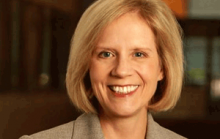When you roll out cloud, never forget the human factor. People will be anxious, they need to know how their roles will change, says NetApp CIO Cynthia Stoddard. It's also important to define how to make decisions about cloud before you start making decisions. A cloud decision framework can save you big headaches down the road, she says. In this interview, Stoddard shares advice and best practices from NetApp's journey to the cloud.
The Enterprisers Project: How has your perception of the cloud changed over the last five years, and what is your perception now?
Sto

ddard: The cloud is becoming an even more powerful tool for IT to become agile. At NetApp we follow a hybrid IT strategy, where we have an internal data center as well as Software-as-a-Service (SaaS) and Infrastructure-as-a-Service (IaaS) instances hosted externally. What’s nice about IaaS is that people can try things using the cloud and if they don’t work they can just shut it off.
The Enterprisers Project: What have you already moved to the cloud and what are you holding off on moving?
Stoddard: Before we do anything cloud related we look at our cloud decision framework. That helps us decide where to place workloads based on where a particular set of data belongs, our existing infrastructure and software assets on the books, and our current software licensing picture. Using the framework, we can decide, for example, to reserve our data center space for specific mission-critical workloads.
The Enterprisers Project: Where have you used open technologies in cloud, and how successful has that been?
Stoddard: We are using some open source in cloud, but on open I would say make sure you target the right areas. In some areas we’ve seen that the tooling isn’t as robust as we thought it would be. You have to ensure you have the right support model. Red Hat has that down pat, but not all open source vendors are as mature. On the whole I would say you should understand what you’re signing up for.
The Enterprisers Project: Do you have any advice or best practices you can share during your journey to the cloud?
Stoddard: One important success factor is to work with the business. If the business doesn’t buy into your cloud strategy they’ll still try to go off and do their own thing. We started our cloud initiatives with them in mind. Bringing them over meant showing them that we built the cloud offering with all the right capabilities in place, such as data backup. We convinced them that working with us was better than going outside and creating shadow IT.
Another success factor is people. Going to the cloud is a big change for an IT organization. We launched a cloud-first strategy at NetApp and at first it scared a lot of people. If I were doing it differently, I would have done some education first on what cloud means and how transferable the people skills are. You still have a very legitimate role in IT as a broker of services, so I would emphasize that you don’t forget about the people aspect.
Finally, with any strategy we have we are very transparent about it and we share it with our enterprise architecture committee. With our cloud strategy, for example, we got their buy-in. Their role was to cascade the strategy through their organizations. IT went out demonstrated cloud’s promise and effectiveness from the top down.
Read "Red Hat CIO: Five lessons for taking your enterprise to the cloud."
Cynthia Stoddard is the senior vice president and CIO at NetApp. In her role as CIO, she is responsible for providing a long-term technology vision that supports and is aligned with the company’s strategies and goals, business plans, operating requirements, and overall efficiencies. She has over 25 years of business experience and IT expertise leading large global organizations in supply chain, retail, and technology companies.




